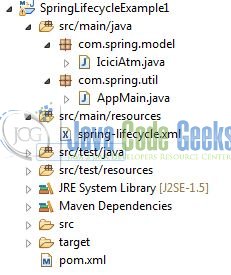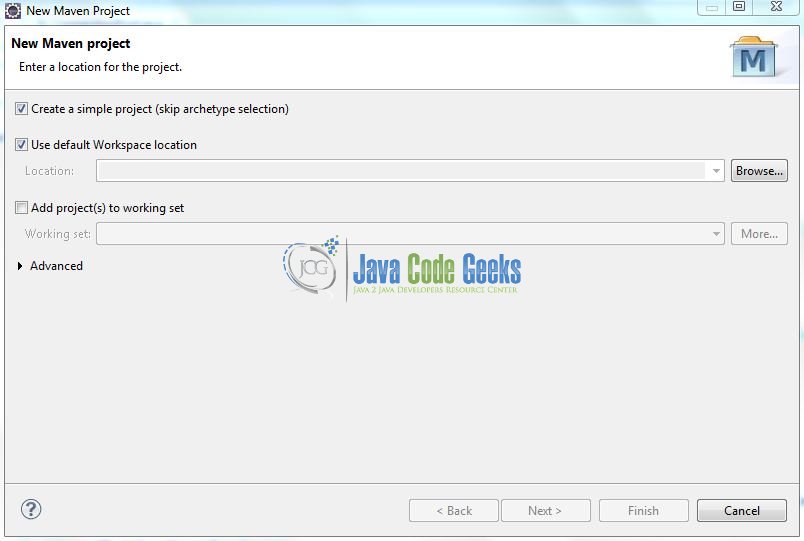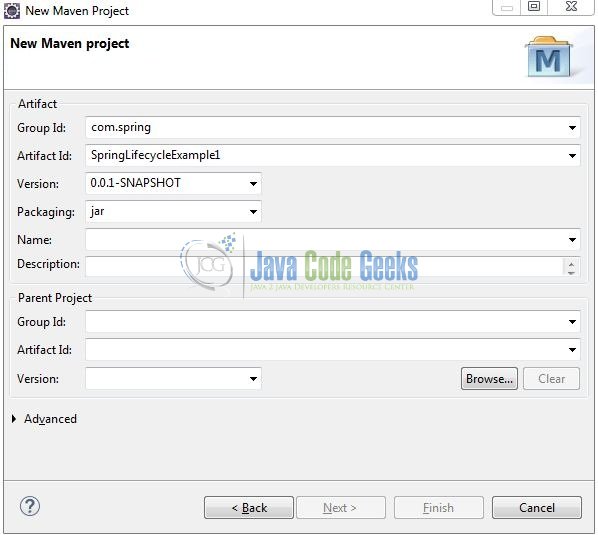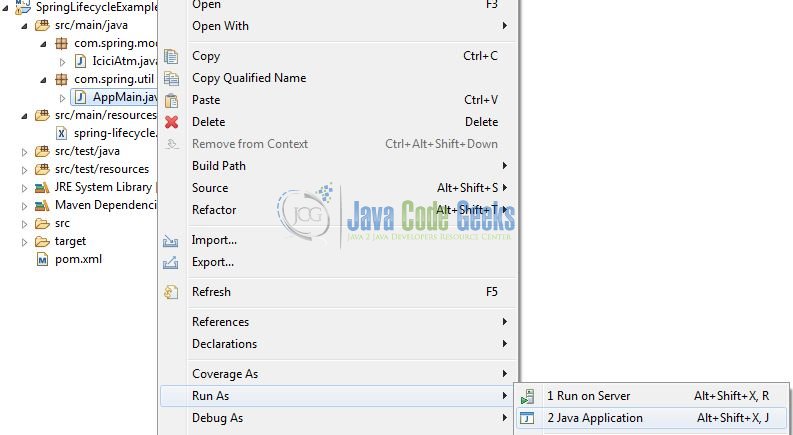Spring init-method and destroy-method Tutorial
Sometimes when the spring beans are created developers need to perform the initialization operations and the cleanup operations before the bean is destroyed. In the spring framework, we can use the init-method and the destroy-method tags in the bean configuration. This tutorial will explore these tags to briefly understand the initialization and destruction.
Table Of Contents
1. Introduction
- Spring is an open-source framework created to address the complexity of an enterprise application development
- One of the chief advantages of the Spring framework is its layered architecture, which allows the developer to be selective about which of its components they can use while providing a cohesive framework for
J2EEapplication development - Spring framework provides support and integration to various technologies for e.g.:
- Support for Transaction Management
- Support for interaction with the different databases
- Integration with the Object Relationship frameworks for e.g. Hibernate, iBatis etc
- Support for Dependency Injection which means all the required dependencies will be resolved with the help of containers
- Support for
RESTstyle web-services
1.1 Spring Bean Lifecycle
Spring bean is responsible for managing the lifecycle of beans created through the spring container. The bean lifecycle consists of post-initialization and pre-destruction callback methods. The following flowchart diagram illustrates the bean lifecycle diagram.
Now, open up the Eclipse IDE and let us see how to implement the init-method and the destroy-method tags in the spring framework!
2. Spring init-method and destroy-method Tutorial
Here is a systematic guide for implementing this tutorial in the spring framework.
2.1 Tools Used
We are using Eclipse Kepler SR2, JDK 8, MySQL and Maven. Having said that, we have tested the code against JDK 1.7 and it works well.
2.2 Project Structure
Firstly, let us review the final project structure, in case you are confused about where you should create the corresponding files or folder later!

2.3 Project Creation
This section will demonstrate how to create a Java-based Maven project with Eclipse. In Eclipse IDE, go to File -> New -> Maven Project.

In the New Maven Project window, it will ask you to select a project location. By default, ‘Use default workspace location’ will be selected. Select the ‘Create a simple project (skip archetype selection)’ checkbox and just click on the next button to proceed.
It will ask you to ‘Enter the group and the artifact id for the project’. We will input the details as shown in the below image. The version number will be by default: 0.0.1-SNAPSHOT.
Click on Finish and the creation of a maven project is completed. If you observe, it has downloaded the maven dependencies and a pom.xml file will be created. It will have the following code:
pom.xml
<project xmlns="http://maven.apache.org/POM/4.0.0" xmlns:xsi="http://www.w3.org/2001/XMLSchema-instance" xsi:schemaLocation="http://maven.apache.org/POM/4.0.0 http://maven.apache.org/xsd/maven-4.0.0.xsd"> <modelVersion>4.0.0</modelVersion> <groupId>com.spring</groupId> <artifactId>SpringLifecycleExample1</artifactId> <version>0.0.1-SNAPSHOT</version> <packaging>jar</packaging> </project>
We can start adding the dependencies that developers want like Spring Core, Spring Context etc. Let us start building the application!
3. Application Building
Below are the steps involved in developing this application.
3.1 Maven Dependencies
Here, we specify the dependencies for the spring framework. Maven will automatically resolve the rest dependencies such as Spring Beans, Spring Core etc. The updated file will have the following code:
pom.xml
<project xmlns="http://maven.apache.org/POM/4.0.0" xmlns:xsi="http://www.w3.org/2001/XMLSchema-instance"
xsi:schemaLocation="http://maven.apache.org/POM/4.0.0 http://maven.apache.org/xsd/maven-4.0.0.xsd">
<modelVersion>4.0.0</modelVersion>
<groupId>com.spring</groupId>
<artifactId>SpringLifecycleExample1</artifactId>
<version>0.0.1-SNAPSHOT</version>
<packaging>jar</packaging>
<dependencies>
<!-- Spring Framework Dependencies -->
<dependency>
<groupId>org.springframework</groupId>
<artifactId>spring-core</artifactId>
<version>5.1.0.RELEASE</version>
</dependency>
<dependency>
<groupId>org.springframework</groupId>
<artifactId>spring-context</artifactId>
<version>5.1.0.RELEASE</version>
</dependency>
</dependencies>
<build>
<finalName>${project.artifactId}</finalName>
</build>
</project>
3.2 Java Class Creation
Let us write the Java classes involved in this application.
3.2.1 Implementation of Bean class
Add the following code to the bean definition:
IciciAtm.java
package com.spring.model;
public class IciciAtm {
String welcomemsg;
public void init() {
System.out.println("ATM init method called. Connecting to bank's network.");
}
public void destroy() {
System.out.println("ATM destroy method called. Disconnecting from bank's network.");
}
public String getWelcomemsg() {
return welcomemsg;
}
public void setWelcomemsg(String welcomemsg) {
this.welcomemsg = welcomemsg;
}
}
3.2.2 Implementation of Utility Class
The implementation class will be able to load the bean definition from the bean configuration file. Add the following code to it:
AppMain.java
package com.spring.util;
import org.springframework.context.support.AbstractApplicationContext;
import org.springframework.context.support.ClassPathXmlApplicationContext;
import com.spring.model.IciciAtm;
public class AppMain {
public static void main(String[] args) {
System.out.println("************** Begin Program **************");
AbstractApplicationContext ac = new ClassPathXmlApplicationContext("spring-lifecycle.xml");
IciciAtm atm = ac.getBean(IciciAtm.class);
System.out.println(atm.getWelcomemsg());
// closing the context object!
ac.close();
System.out.println("************** End Program **************");
}
}
3.3 Bean Configuration file
In the spring xml configuration, we can configure the initialization and destruction methods using the init-method and destroy-method attributes of the <bean /> element.
spring-lifecycle.xml
<?xml version="1.0" encoding="UTF-8"?> <beans xmlns="http://www.springframework.org/schema/beans" xmlns:xsi="http://www.w3.org/2001/XMLSchema-instance" xsi:schemaLocation="http://www.springframework.org/schema/beans http://www.springframework.org/schema/beans/spring-beans-3.0.xsd"> <!-- Atm bean definition --> <bean id="atm" class="com.spring.model.IciciAtm" init-method="init" destroy-method="destroy"> <property name="welcomemsg" value="Welcome to Icici bank Atm" /> </bean> </beans>
4. Run the Application
To execute the application, right click on the AppMain class, Run As -> Java Application. Developers can debug the example and see what happens after every step. Enjoy!
5. Project Demo
The code shows the following log as the output of this tutorial.
/* Output logs of the application */ ************** Begin Program ************** ATM init method called. Connecting to bank's network. Welcome to Icici bank Atm ATM destroy method called. Disconnecting from bank's network. ************** End Program **************
That is all for this tutorial and I hope the article served you whatever you were looking for. Happy Learning and do not forget to share!
6. Conclusion
This post defines the initialization and destruction of the spring bean using the xml configuration tags. Always remember, you must specify the method names that have a void no-argument signature.
6.1 Trailing notes
If there are multiple beans in the configuration file that needs to perform the initialization and destruction activities, and all the beans have the same method signature, under those circumstances, it is advisable to define them using the default-init-method and default-destroy-method tags.
<?xml version="1.0" encoding="UTF-8"?> <beans xmlns="http://www.springframework.org/schema/beans" xmlns:xsi="http://www.w3.org/2001/XMLSchema-instance" xsi:schemaLocation="http://www.springframework.org/schema/beans http://www.springframework.org/schema/beans/spring-beans-3.0.xsd" default-init-method="init" default-destroy-method="destroy"> <!-- Bean definitions --> </beans>
Developers can download the sample application as an Eclipse project in the Downloads section.
7. Download the Eclipse Project
This was an example of Spring init-method and destroy-method.
You can download the full source code of this example here: SpringLifecycleExample1








While your solution works, it only works if you adopt the Spring-framework… Many people, including myself prefer a solution that is independent of a particular framework and just works.
You don’t need all the overhead of the XML-Configuration and Bean-wiring and the Spring framework if you just use the @PostConstruct and @PreDestroy annotations — these has been part of core-Java since 1.5 and also avoids any framework dependencies on Spring.
@PostConstruct
public void init() {
System.out.println(“ATM init method called. Connecting to bank’s network.”);
}
@PreDestroy
public void destroy() {
System.out.println(“ATM destroy method called. Disconnecting from bank’s network.”);
}
Many thanks, Gregory. Genuinely this is a basic tutorial which is a part of three other tutorials interlinked with one and other (Regarding the bean lifecycle in the spring framework). Thanks again and have a great day!